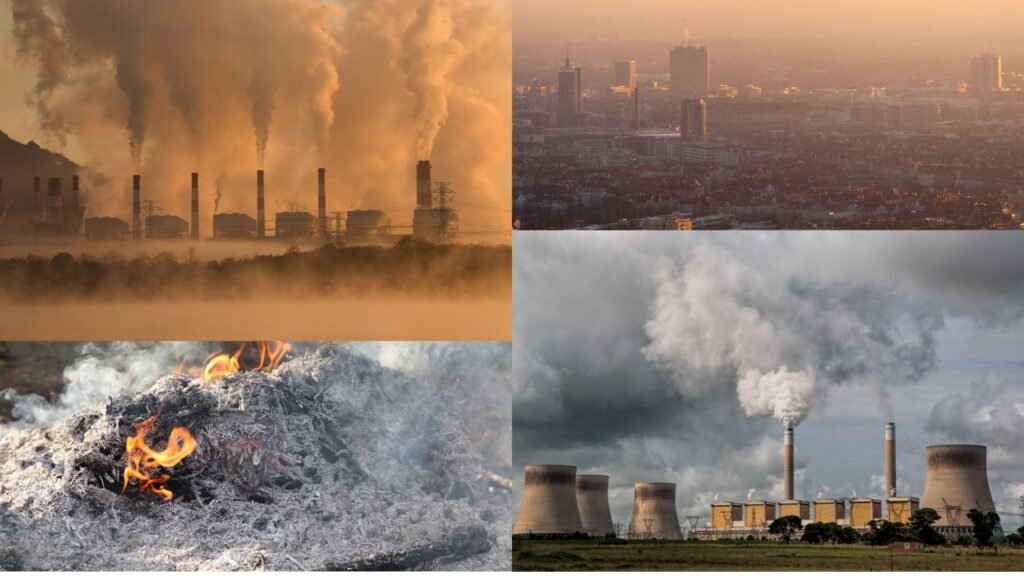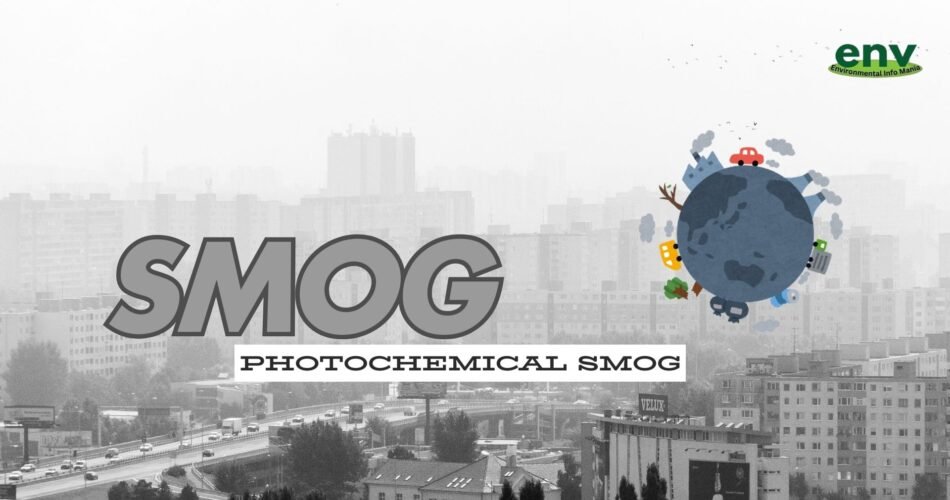This blog is all about Smog and Photochemical Smog with their Impacts on Humans and Environment. It also discusses the main gases that contributes in Smog Formation. It also elaborates the Sources of Smog Pollution. This also explains the difference between Photochemical Smog and Smog.
1. What is the definition of Smog?
Smog can be defined as a mixture of Atmospheric Pollutants with dust and smoke combined. Smog is the Type of Air Pollution that reduces visibility and form thick haze into the Environment.
The Smog is a very crucial Environmental Problem of the present era. Smog is the haze that produces as a result of Extreme Air pollution in colder temperatures. It is a great challenge for living things on Earth by disturbing them in their Routine Activities, Health, Transportation, and in many other important activities. In the start, the smog was not so swear and it was not under consideration. But with passing time, the Smog became more extreme and concentrated because of increasing Air pollutants in the Environment. The smog is now a very crucial Environmental Problem in the Environment.
This blog contains all relevant information about Smog and Photochemical Smog with their Impacts. This blog is the complete explanation of Smog and Photochemical Smog.
2. Is Smog Natural or Anthropogenic Pollution?
Smog can occur with Natural Phenomena as well as Anthropogenic Activities. Smog is a mixture of Air pollutants that can be released from both ways. For example, a huge concentration of Green House Gases is released in the atmosphere when a Volcano is erupted. These gases contributes in the formation of Smog. While human activities such as Industrialization, Transportation, Fossil Fuel Burning, Deforestation also contributes in the formation of Smog.
The Smog is the Extreme Impact of Air pollution. It will occur in the places where the Air Quality or Air Quality is very bad and filled with Air Pollutants. So, we can say that Smog can be Natural or Anthropogenic Pollution in Nature.
3. What are the Types of Smog and How do Smog Form?
Smog can be of two types. Both have bad impacts on the Health of people and the Environment. But the difference is their production ways and conditions. Following are the two types of smog:
I. Photochemical Smog:
Photochemical Smog is the smog that is produced in the presence of sunlight. It is the summer smog, because it forms when there is extreme heat and bright sunlight in the Environment.
Formation of Photochemical Smog:
It forms when major Air Pollutants such as COX, SOX and NOx etc. interacts with sunlight. It is most of the time invisible but it is very dangerous for the Health of Environment and Biodiversity. This leads to the Respiratory Disorder, Cardiovascular diseases, Lung diseases and is also sometimes Carcinogenic.
II. Industrial Smog or Sulfurous Smog:
Industrial Smog or sulfurous smog is the smog that is produced in cold weather. It is the smog that reduces visibility and it is extremely harmful for human health and Biodiversity.
Formation of Industrial Smog or Sulfurous Smog:
This kind of smog forms when the Major Air Pollutants, interacts with water droplets and due to cold weather, they suspends into the air. It is a mixture of Fog and Smoke. Most of the time it is seen in extremely Industrial Area. It is also harmful for Respiratory System of living things and damage plants.

4. What are the Gases involved in Smog Formation Process?
There are many harmful and toxic Air Pollutants that contributes in the Smog Formation. Following are the gases that involves in Smog Formation:
- Tropospheric Ozone
- Particulate Matter
- Carbon Monoxide
- Nitrogen Oxides
- Sulfur Oxides
Tropospheric Ozone:
The most primary component of Smog is Tropospheric Ozone. It is created when Nitrogen Oxides NOx and VOCs reacts with Sunlight. This is a dangerous air pollutant and is toxic even in a very small concentration. It associates with many Health disorders in Humans and Living Organisms.
Particulate Matter:
Particulate matter includes the dust and pollens primarily. While secondary particulate matter includes SOX, Ammonia, and VOCs etc. It is also an integral part of Smog Formation as it creates suspended particles into the in order to reduce visibility. All of the Particulate Matter are unhealthy for us.
Carbon Monoxide:
CO is a very dangerous Air pollutant that is involves in Smog Formation. This gas has the common source of Motor vehicles. Many natural activities also emits CO gas into the atmosphere. The natural activities that emits CO are Volcanoes, bushfires etc.
Nitrogen Oxides:
Nitrogen is also a very important part of Smog Formation. It can emit from motor vehicles, construction activities, power plant, cement kilns and Industrial activities. These gases are poisonous and basically comes from burning or Nitrogen based Fuels in the Industries.
Sulphur Dioxide:
Sulphur Dioxide is a very harmful Air pollutant that is dangerous in any range of Concentration. It is also a primary part of Acid rain. This gas can come from Motor Vehicles, Burning of Sulfur containing Fuels, Volcanoes etc. This forms haze and reduce visibility during Smog.
These are the few gases that are important for Smog Formation.
5. What are major Causes of Smog?
Following are some Significant Causes of Smog Pollutants:
- Vehicle Emissions
- Volcanic Eruptions
- Burning of Fossil Fuels
- Weather Conditions
- Oceans
- Agricultural Emissions
i. Vehicle Emissions:
All the fuel utilizing vehicles, emits different types of pollutants that involves in Smog Formation. Vehicles emits CO, CO2, NOx, SOX etc. These gases involves in the formation of haze and reduction in visibility and also cause many health problems when people are exposed to them. Transportation is the biggest source of Green House Gases production.
ii. Volcanic Eruption:
The Volcanoes contains SOX, NOx and COX in it. The explosive eruptions throw these gases directly into the upper atmosphere in order to add it to the Atmospheric Composition. In this way large concentration of these gases revolves into the Environment an ends up producing Smog and Acid Rain that are extremely harmful for Living Organisms.
iii. Burning of Fossil Fuels:
Fossil Fuels are the dead remains of organisms and Natural resources formed in thousands of years. Their burning is very harmful as it adds harmful and toxic materials to the Environment. They almost emits all the gases that involves in Smog formation. The burning of fossil fuel is good for the Economic context but it is very dangerous for the Environmental Conditions.
iv. Weather Conditions:
Weather is the short term state of atmosphere that rises due to changings in the atmosphere. The weather patterns and conditions play a very important role in smog formation. Because weather conditions are responsible for the dispersion of the pollutants over a large area. And then pollutants of a small geographical area becomes the cause of Smog over a large geographical area.
v. Oceans:
Oceans are spread over 70% areas of the Earth. So, many gases are released from the ocean due to many life processes and pollutions into the Ocean. The Oceans emits CO2, NOx etc. As there are huge Oceans on Earth so, we can say that Oceanic Pollution and Pollutants also contributes in the Smog Formation. We should keep the oceans clean to avoid Ocean Acidification and Smog.
vi. Agricultural Emissions:
As we know that the world is going to face Food insecurity due to rise in Population. Every farmer on Earth is trying to increase their yield to make it beneficial and enough for the population and the Economy. They are using Non-sustainable farming practices by using synthetic Fertilizers, Pesticides etc. I.e. Intensive Farming. The Nitrogen and Sulfur based fertilizers produce NOx and SOX into the atmosphere, that are part of Smog.
These are some of the Natural and Anthropogenic Sources of Smog Formation. Basically it is the matter of gases that are found in the atmosphere. If highly toxic Atmospheric Pollutants would be present in the Atmosphere, they will cause Smog Formation. This blog is all about Impacts of Smog and Photochemical Smog.
6. What is Photochemical Smog?
It is a mixture of pollutants that are formed when nitrogen oxides and VOC (Volatile Organic Compounds) react with sunlight and creates a brown haze over cities.
Unlike smog, the photochemical smog forms in extremely high temperature during the peak summers. It forms when there is most sunlight available for reaction. The pollutants that are the cause of Smog, same are the cause of Photochemical Smog. But the difference is that, Smog forms when smoke and fog reacts in winters and cold temperatures while Photochemical Smog forms in high temperatures in the presence of Maximum Sunlight. The Impacts of both these Smog are almost similar on Human Health and the Environment.
This blog contains all the details about Smog and Photochemical Smog along with their Impacts.
7. What is the Difference between Industrial Smog and Photochemical Smog?
Industrial Smog or Sulfurous Smog
Photochemical Smog
i. Industrial Smog is formed by sulfur oxides and particulate matter present in the Atmosphere.
i. Photochemical Smog is formed by photochemical reactions of sunlight and Nitrogen oxides.
ii. Sulfurous Smog involves Fog and Smoke for its Formation in the Environment.
ii. Photochemical Smog does not involve Fog and Smoke for its Formation.
iii. This smog has high concentration of SO2 in its composition.
iii. The Photochemical Smog has high concentration of Oxidizing agents.
iv. It was observed in London in 1952 for the first time in the History; called Great Smog of London.
iv. It was observed in Los Angeles in 1950 for the first time in the History.
v. Smog is always formed in the cold temperatures and absence of Sunlight.
v. Photochemical Smog is formed in the maximum sunlight and extremely hot temperatures.
vi. Sources: Automobiles, Volcanoes etc.
vi. Sources: Industrial Activities, Transportation etc.
8. What are the Health Effects of Smog?
Following is the list of Impacts of Smog on Human Life:
- Smog may cause Eye and Nose Irritation and Inflammation in Humans during Smog Season.
- It can also trigger Respiratory diseases and Allergies due to Air quality deterioration. It can trigger Asthma, Tuberculosis, Pneumonia etc.
- This can also lead to sore throat and scratchy throat.
- It can also effect the functioning of Lungs and you can be short of breathe at any instant.
- You may be exposed to tight chest and Lung Inflammation such as Bronchitis etc.
- Smog periods are very difficult for the people who have Sinus issues and Flu.
- This can be very painful season for Allergic people and also Older people who have weak immune systems.
These are the Impacts of Smog on Human Life. This blog is all about Impacts of Smog and Photochemical Smog.
9. What are Smog Effects on the Environment?
Following are the Effects of Smog on the Environment:
- Smog reduces visibility at great levels, it makes difficulties in travelling of Humans and other Biodiversity because you can hardly see in smog.
- It also damages plants and animals with suspended pollutants into the air. It can disturb the photosynthesis process in Plants.
- This can also prove dangerous for the crops and may damage them with great power.
- This is the leading cause of Acid Rain because through smog, the air pollutants persists into the environment and with evaporation, they form Acid rain.
- It also contributes in Environmental Degradation and can also effect the fertility of the soil by adding different pollutants to it.
- Smog can disturb normal activities of animals and may cause death of sensitive animals in the Environment.
- Smog also destroys the Sensitive Ecosystems by harming the physical properties and Biodiversity in those Ecosystems.
These are some of the Impacts of Smog on the Environment. This blog is all about Impacts of Smog and Photochemical Smog.
10. How can we control the Smog?
Smog and Acid Rain are the natural phenomena that are completely in control of Air Pollution. If we want to control the Smog, we should work on the prevention of Air Pollution and its sources. For example, most of the Air Pollution is from Transportation and Industrial Activities. We should makes strategies to control Air Pollution from both of these sources. If there will be no harmful gases into the Atmosphere, the Smog will not form and its extreme effects will be reduced. We should take care while going out during the smog season in order to avoid extreme Health Conditions caused by Smog. Following are some ways to Control Smog:
Renewable Energy Adoption:
Renewable energy sources such as Solar, Wind, Biomass etc. are suitable as compared to Fossil Fuel Burning because they emit less air pollutants than conventional ways. The Renewable Energy Adoption can help us to fight with extreme weather events such as Smog, Acid Rain, Storms etc.
Government Policies:
We should take extremely serious action on System and Policy level on Smog prevention. For example; we should have more policies like Clean Air Act (1963) that was passed for Air Pollution Control and National Clean Air Programme (NCAP) that was passed to reducing Particulate Matter in the country etc.
Technological Implications:
Technology can help us to beat such Environmental Issues in many different ways. For Example, the use of Electric Vehicles, Smog Tower, Air Purifiers on large levels, Air Quality Monitoring and many other Anti-smog technologies can help us to reduce or prevent smog formation in the polluted areas etc.
Sustainable Urban Planning:
The Sustainable Urban Planning involves the establishment of enough Green Spaces, Urban Forests, Sustainable Development Projects and Biodiversity conservation in the urban areas. It also include better planning for industrial and residential areas to avoid Extreme Impacts of Smog.
All of these steps are equally important in the prevention of Smog. If you want to learn more about How to Prevent Smog? Click the mentioned link. This blog is all about Impacts of Smog and Photochemical Smog.
11. What are some Case studies of Severe Smog Problems?
Following are some Case Studies containing Severe Smog Problems in the History:
1) The Great Smog of London (1952):
The Great Smog of London 1952, was the most severe Smog event in the history. It was the first time when a thick layer of smog due to cold weather covered London trapping the coal pollutants in and windless condition. It resulted in 12,000 deaths and 100,000 illnesses.
2) Coal Smog (1880):
During the period of Industrial Resolution in 1880, London experiences severe Smog due to the extreme use of Coal Burning. About 2200 people died in this Smog. Travelling was disputed for days and people face many health and travelling issues.
3) Donora Smog (1948):
In Donora, Pennsylvania, the emissions from a Zinc and Iron work plant became trapped in the temperature inversion. It created thick smog that lasted over five days. It cause severe Respiratory damage and resulted in about 20 deaths.
4) Meuse Valley Smog (1930):
Meuse is a Valley in Belgium. In 1930, the emissions from the factories combined with weather conditions and resulted in severe smog. It became the cause of death for about 60 people because of respiratory illnesses and congestion.
5) Smog in London (1991):
1991 again took a Smog disaster in London. This time the smog was produced as the result of Transportation emissions and other pollutants in London. The Smog of 1991 took lives of 160 people because of its severe health effects.
6) Delhi Smog:
Delhi is the capital of India. This city is experiencing extreme Air Pollution from many years. The smog formed by the Industrial Activities, Construction Activities, Transportation Emissions and Meteorological Conditions, in Delhi is called as Delhi Smog. This is getting world’s attention every year due to extreme impacts on Health and Environment.
7) Beijing Smog:
Beijing is the Capital of China. In Beijing, there are many Heavy Industries, Rapid Economic Growth, and Lax Environmental Regulations due to rapid Economic Growth. The Beijing Smog is a model for other cities in order to understand the consequences Economic Growth and Pollution. Fortunately, Beijing Air Quality has improved between the years 2013 to 2022.
These are some of the Severe Smog Events Case Studies happened in the history. This blog is all about Impacts of Smog and Photochemical Smog.

12. Conclusion:
Smog is a mixture of atmospheric pollutants that cause many bad impacts on Human and Environment. It is formed by the mixing of Fog and Smoke in the Winter Season. The main Sources of Smog are Volcanoes, Fossil Fuel Burning, Oceans etc. The gases involved in Smog formation are Ozone, COX, NOx, SOX etc. Photochemical Smog is the smog that produces in the presence of Maximum Sunlight in the Summer Season. The difference between Smog and Photochemical Smog is in the above details.
The impacts of Smog on Humans includes; Lung diseases, Allergies, Asthma, Bronchitis etc. While the Impacts of Smog on the Environment includes; Reducing Visibility, Environmental degradation, Disturbances in Natural Ecosystems, Damage crops and plants etc. For reducing the extreme impacts Smog, we should work on reducing Air Pollution in the whole world. We should stay cautious about Smog before getting any disorder or disease through it. This blog is all about Impacts of Smog and Photochemical Smog.
To learn about more topics, Click the links below:


Comments